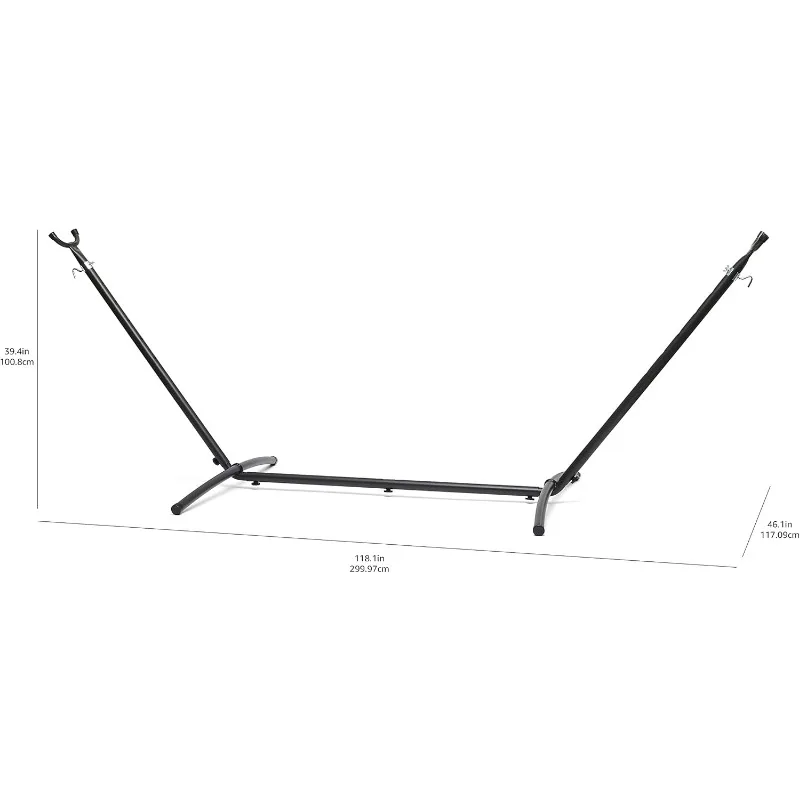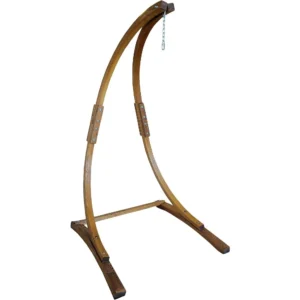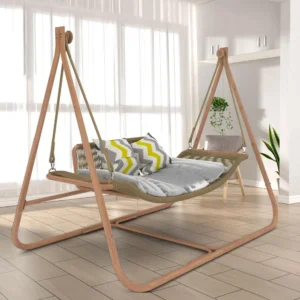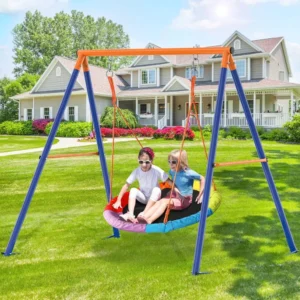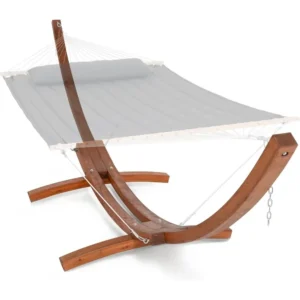Why Choosing the Right Hammock Stand Material Matters
The material of your hammock stand isn’t just a matter of aesthetics—it fundamentally shapes your entire relaxation experience. Whether you’re setting up a permanent relaxation spot in your backyard or looking for something you can easily move between indoor and outdoor hammock placement, your choice of material will determine durability, stability, and how well your hammock integrates with your space.
Steel and wood represent the two primary options for hammock stands, each bringing distinct advantages and considerations. Steel offers modern durability and often greater portability, while wood provides timeless aesthetics and a natural feel. The right choice depends on your specific needs: where you’ll place it, how often you’ll move it, and what kind of maintenance you’re willing to perform.
In this guide, we’ll explore both options in depth, helping you understand exactly which material aligns best with your relaxation goals and lifestyle.
The Advantages of Steel Hammock Stands
Steel hammock stands have become increasingly popular due to their practical benefits and modern appeal. Here’s why they might be the right choice for your relaxation needs:
Superior Strength and Durability: Powder-coated steel construction offers exceptional strength-to-weight ratio, with quality stands typically supporting 400-500 pounds (180-225 kg).
Weather Resistance: The powder coating technology provides effective protection against rust and corrosion, making steel stands suitable for various outdoor conditions.
Low Maintenance Requirements: Unlike wood, steel stands generally need minimal upkeep—just occasional cleaning to maintain their appearance and functionality.
Portability Benefits: Many steel stands are designed with mobility in mind, featuring lightweight components, foldable designs, and easy assembly/disassembly processes that make them ideal for changing locations.
Modern Aesthetic: Steel stands offer clean lines and contemporary styling that complement modern outdoor living spaces and furniture designs.
Versatility: Steel stands typically accommodate various hammock types and sizes, from traditional rope hammocks to modern quilted designs.
Many portable hammocks stands feature innovative folding mechanisms that allow them to collapse into compact forms for easy storage in garages or closets during off-seasons, making them particularly convenient for those with limited space.
Potential Drawbacks of Steel Hammock Stands
While steel stands offer numerous benefits, they aren’t without limitations that should be considered before making your purchase:
Rust Vulnerability: Even with powder coating protection, scratches or chips can expose the metal underneath to moisture, potentially leading to rust development—particularly concerning in coastal areas where salt exposure accelerates corrosion.
Heat Retention: Metal stands can become uncomfortably hot when left in direct sunlight during summer months, creating potential safety concerns.
Weight Variations: While many steel stands emphasize portability, some heavier-duty models can still be quite substantial to move, especially for one person.
Aesthetic Limitations: In natural garden settings, the industrial appearance of steel might clash with the organic surroundings, depending on your landscape design.
Surface Vulnerability: The protective coating can become scratched or damaged over time, affecting both appearance and weather resistance.
If you’re considering leaving your hammock setup outdoors year-round, it’s worth learning about proper care and protection to ensure longevity. Understanding whether it’s okay to leave hammocks outside can help you make appropriate maintenance decisions for your steel stand.
The Natural Charm of Wooden Hammock Stands
Wooden hammock stands offer a distinct visual appeal and natural connection that metal alternatives simply can’t replicate. Here’s what makes them special:
Unmatched Aesthetics: Wood stands bring warmth, character, and natural beauty to any setting, creating a visual centerpiece rather than just functional support.
Material Variety: Quality wooden stands use carefully selected materials like cypress for rot resistance, cedar for natural insect repellent properties, or larch for exceptional strength and durability.
Inherent Stability: The substantial nature and design of wooden stands—particularly arc-shaped models—provides excellent weight distribution and stability.
Decorative Value: Beyond their functional purpose, wooden stands serve as statement pieces that enhance garden aesthetics, creating a dedicated relaxation zone.
Broad Compatibility: Traditional wooden designs often accommodate hammocks of various sizes and styles without the size limitations sometimes found in steel options.
Environmental Benefits: Stands crafted from sustainably harvested wood with FSC certification offer eco-friendly alternatives for environmentally conscious consumers.
Time-Tested Design: The curved arc design common in wooden stands has been refined over generations for optimal comfort and stability.
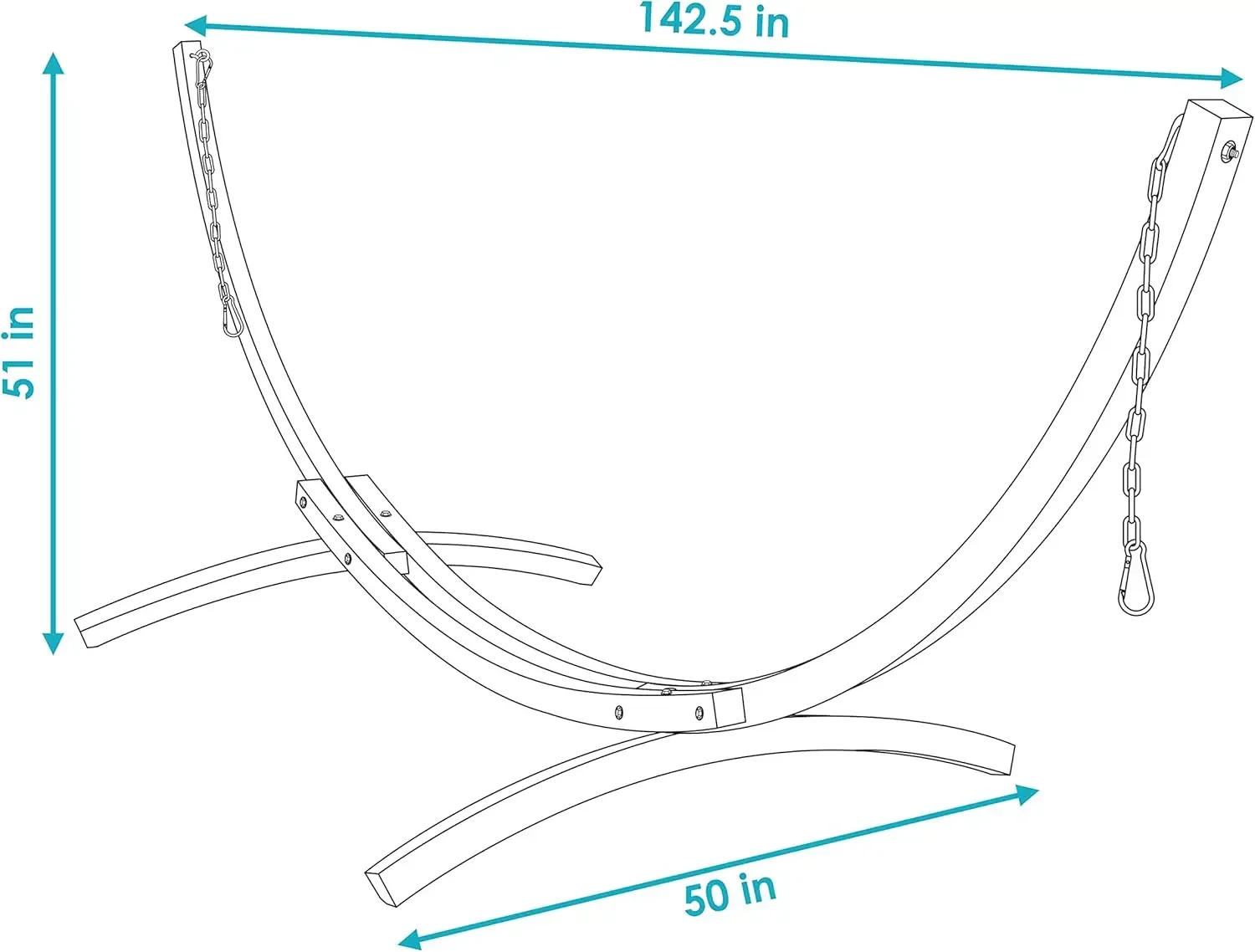
For those seeking the authentic, natural look that only wood can provide, exploring different wooden hammocks stands options can help you find the perfect match for your outdoor space.
Caring for Wooden Hammock Stands: Maintenance Considerations
The natural beauty of wooden hammock stands comes with specific maintenance requirements that should factor into your decision:
Regular Protection: Wooden stands require periodic sealing, staining, or oiling—typically 1-2 times per year depending on climate and exposure—to maintain their appearance and structural integrity.
Weather Vulnerability: Without proper maintenance, wooden stands become susceptible to weathering effects: sun exposure can cause fading and drying, while moisture can lead to rot or warping.
Weight Considerations: Most wooden stands weigh between 30-45 pounds (14-20 kg), making them significantly heavier than portable steel alternatives and more challenging to relocate.
Investment Value: Quality wooden stands often come with higher initial costs, reflecting the craftsmanship and materials involved, though their aesthetic appeal and longevity can justify this premium.
Seasonal Storage: In regions with harsh winters, you might need to store your wooden stand indoors or use protective covers to prevent damage from freezing temperatures and moisture.
The traditional beauty of wooden arc stand hammock sets creates a stunning focal point in any garden or patio, but this visual appeal requires commitment to proper maintenance to preserve both appearance and functionality over the years.
Head-to-Head Comparison: Steel vs. Wood Hammock Stands
When deciding between steel and wood hammock stands, consider how they compare across these key factors:
| Factor | Steel Stands | Wooden Stands |
|---|---|---|
| Durability | 7-15+ years with proper care; resistant to insects | 7-15+ years with regular maintenance; susceptible to insects/rot |
| Weather Resistance | Good resistance with intact coating; potential for rust | Requires regular sealing; vulnerable to sun/moisture damage |
| Maintenance | Low; occasional cleaning and inspection | High; regular sealing/staining (1-2 times yearly) |
| Aesthetics | Modern, sleek, industrial | Natural, warm, traditional, rustic |
| Portability | Often lightweight (15-25 lbs/7-11 kg); some foldable | Heavy (30-45 lbs/14-20 kg); rarely portable |
| Weight Capacity | Typically 250-500 lbs (113-225 kg) | Typically 300-450 lbs (136-204 kg) |
| Price Range | $60-200 for quality options | $150-400 for quality options |
| Assembly | Usually simpler with fewer parts | Can be more complex with multiple pieces |
| Environmental Impact | Metal production energy-intensive; recyclable | Varies by wood sourcing; sustainable options available |
Understanding the strongest materials for hammock stands can provide additional context for making your decision based on durability and weight capacity needs.
Ideal Scenarios: When to Choose Steel vs. Wood
Different environments and usage patterns clearly favor one material over the other:
Steel stands work best when:
* You need portability for camping, beach trips, or frequent location changes
* You prefer minimal maintenance requirements
* You have an exposed outdoor location with changing weather conditions
* Your aesthetic preferences lean toward modern, contemporary designs
* You have a limited budget but want durability
* You need to store your stand during off-seasons
Wooden stands excel when:
* You’re creating a permanent relaxation spot in a garden, patio, or deck
* You value natural aesthetics and traditional appearance
* You don’t mind regular maintenance to preserve appearance
* You’re looking for a visual centerpiece rather than just functional support
* You prefer the stability and substantial feel of heavier construction
* You’re placing your hammock in a partially protected outdoor area
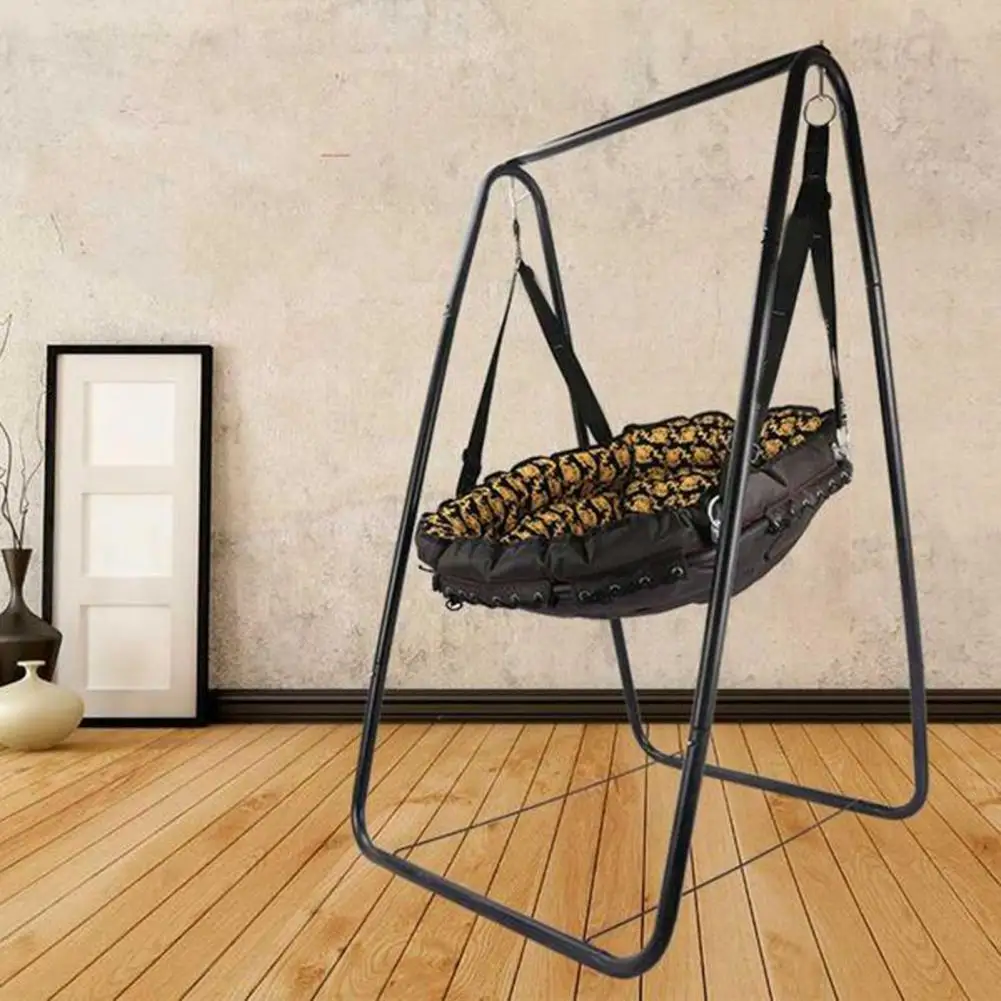
For specific settings, the design style matters as much as the material. A-frame stand hammock sets offer a distinct look and functionality that works in different spaces regardless of material choice.
Key Features to Look for in Quality Hammock Stands
Beyond just material choice, these specific features differentiate premium stands from basic options:
For Steel Stands:
* Powder coating thickness of at least 2-3 mils for optimal protection
* Welded joints rather than only bolted connections for superior stability
* Rubber or plastic end caps on feet to prevent slipping and protect flooring
* Clear weight capacity specifications (look for at least 300 lbs/136 kg)
* Weather-resistant hardware that won’t easily rust or corrode
* Tool-free assembly or minimal tool requirements for convenience
For Wooden Stands:
* Pre-treatment with weather-resistant sealants or stains
* Stainless steel or galvanized hardware to prevent unsightly rust stains
* Reinforced joinery at stress points for long-term durability
* Smooth, splinter-free finishing on all surfaces
* Properly dried wood to prevent future warping or cracking
* Clear, detailed assembly instructions with pre-drilled holes
Considering these quality indicators alongside proper hammock installation requirements and safety guidelines ensures you select a stand that provides both security and satisfaction.
Dark Wood Hammock Sets, Porch Swing Chair Sets
$653.82 Select options This product has multiple variants. The options may be chosen on the product pageA-Frame Stand Hammock Sets, Swinging Hammock Chair Sets
$154.62 Select options This product has multiple variants. The options may be chosen on the product pageLight Wood Hammock Sets, Swinging Hammock Chair Sets
$1,359.35 Select options This product has multiple variants. The options may be chosen on the product pageClassic Wooden Stand Hammock Sets, Heavy Duty Hammock Sets
$1,061.68 Select options This product has multiple variants. The options may be chosen on the product pageFolding Hammock Sets, Quick Setup Hammock Sets
Price range: $305.52 through $583.27 Select options This product has multiple variants. The options may be chosen on the product pageHeavy Duty Hammock Sets, Wooden Arc Stand Hammock Sets
$878.66 Select options This product has multiple variants. The options may be chosen on the product page
Special Considerations for Different Environments
The environment where you’ll place your hammock stand significantly impacts which material will perform best:
Coastal/High-Humidity Environments:
* Steel stands need extra protection against salt air—consider additional protective clear coats
* Wooden stands benefit from more frequent sealing (every 3-6 months) and marine-grade finishes
* Both materials should be rinsed occasionally to remove salt deposits
Desert/High-Sun Environments:
* Steel stands may become too hot to touch during peak sun hours
* Wooden stands need UV-protective finishes to prevent drying and cracking
* Consider placement in partial shade for both material types
Seasonal Climate Changes:
* Steel stands with removable fabric need winter storage protection for the fabric components
* Wooden stands benefit from protective covers during extended rainy seasons
* Both materials should be secured or stored during high wind events
Indoor Spaces:
* Steel stands typically require less floor space (average footprint: 9-12 ft²/0.8-1.1 m²)
* Wooden stands generally need larger clearance areas (average footprint: 12-15 ft²/1.1-1.4 m²)
* Consider ceiling height for arc-style wooden stands (minimum 7.5 ft/2.3 m recommended)
Finding the best indoor outdoor hammock locations can help you determine which material will work better for your specific setting.
How to Maximize the Lifespan of Your Hammock Stand
With proper care, both steel and wooden hammock stands can provide many years of reliable service:
For Steel Stands:
* Inspect the coating twice yearly for scratches or chips that could allow moisture to reach the metal
* Touch up any damaged areas immediately with matching paint to prevent rust formation
* Clean with mild soap and water, avoiding abrasive cleaners that might damage the protective coating
* Apply a silicone spray to moving parts or joints annually to maintain smooth operation
* Store portable stands in their carry bags when not in use to protect against scratches
For Wooden Stands:
* Apply a quality water-resistant sealer or marine varnish before first use and reapply annually
* Clean with gentle wood-appropriate cleaners, avoiding pressure washers that can damage the grain
* Check joinery points seasonally and tighten any loose hardware promptly
* Look for early signs of water damage or insect activity and address immediately
* Use protective covers during extended periods of non-use, especially in winter months
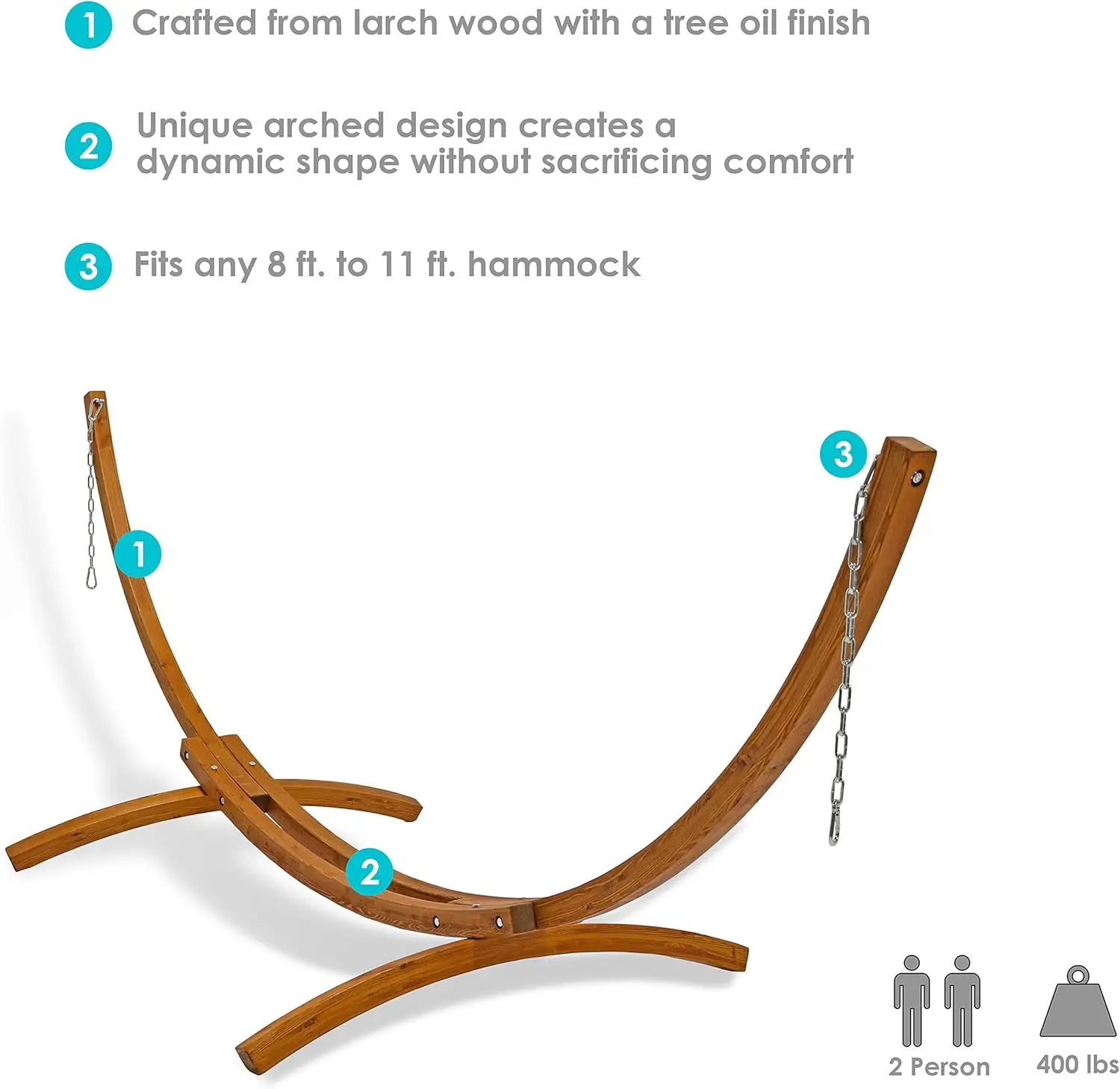
For those who appreciate traditional design elements, classic wooden stand hammock sets offer timeless appeal that will look beautiful for years with proper care and maintenance.
Beyond Materials: Additional Factors to Consider
When selecting your hammock stand, these additional considerations can influence your overall satisfaction:
Assembly Complexity:
* Steel stands typically involve fewer parts (5-10 pieces) and simpler assembly
* Wooden stands often have more components (10-20 pieces) and may require more tools
* Consider whether you’ll need to assemble and disassemble frequently
Storage Requirements:
* Foldable steel stands can collapse to dimensions as small as 4’ × 8” × 8” (122 × 20 × 20 cm)
* Wooden stands rarely disassemble completely for storage, requiring dedicated space
* Factor in off-season storage needs, especially for regions with harsh winters
Multi-Functionality:
* Some stands accommodate both hammocks and swing chairs with minor adjustments
* Consider stands with attachment points for accessories like cup holders or tablet stands
* Look for models with adjustable height or length for different hammock types
Understanding whether you can use a tree with your hammock stand adds another dimension of versatility to consider when making your selection.
Frequently Asked Questions About Hammock Stands
Can I leave my hammock stand outside year-round?
Steel stands with quality powder coating can generally remain outdoors, though the hammock itself should be stored during wet weather. Wooden stands benefit from protection during winter months or periods of extreme weather to extend their lifespan.
How do I prevent rust on my steel hammock stand?
Regular inspection for coating damage, prompt touch-up of scratches, and occasional cleaning are key. Consider using a protective cover during extended periods of non-use, especially in humid or coastal environments.
How often should I treat my wooden hammock stand?
For stands in full weather exposure, apply a quality sealer or protective finish every 6-12 months. Those in covered areas may need treatment only annually. Look for signs of drying wood (color lightening) as an indicator that treatment is needed.
Are wooden stands worth the higher price?
If aesthetics are a priority and you don’t need portability, wooden stands offer distinctive visual appeal and can serve as garden focal points. Their investment value comes from both functionality and decorative quality.
What’s the safest option for families with children?
Both materials can be equally safe when properly constructed. Look for stands with rounded edges (especially on wooden models) and stable designs with wide bases. Always check weight capacity and follow manufacturer guidelines.
Making Your Final Decision: A Summary Guide
When choosing between steel and wooden hammock stands, prioritize the factors most important to your situation:
For portability and ease of maintenance, steel stands offer clear advantages. They’re generally lighter, often foldable, and require minimal upkeep beyond occasional cleaning and inspection. They excel in situations where you might move your hammock frequently or need to store it during off-seasons.
For aesthetic appeal and creating a permanent relaxation space, wooden stands are unmatched. Their natural beauty and substantial presence make them ideal for dedicated hammock areas in gardens, on decks, or in spacious indoor settings where their visual impact will be appreciated.
Your environment plays a crucial role—coastal locations with salt exposure may favor specially treated wooden stands or premium powder-coated steel, while areas with extreme temperature variations might benefit from the adaptability of steel stands with proper protection.
Ultimately, the right choice aligns with your specific priorities: portability versus permanence, minimal maintenance versus natural aesthetics, and modern versus traditional styling. By weighing these factors against your personal preferences, you’ll find the perfect foundation for countless hours of suspended relaxation.

